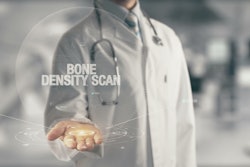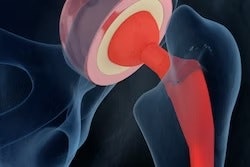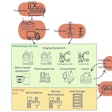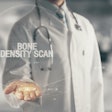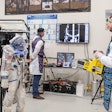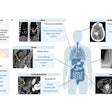Dual-energy x-ray absorptiometry (DEXA) scans show that high-velocity resistance training increases bone mineral density in older adults, according to a study published December 7 in Bone.
In a literature review of studies that included 1,203 people, DEXA scans revealed significant effects of high-velocity resistance training on bone mineral density (BMD) at the lumbar spine, total hip, and femoral neck, according to a group led by Dawn Skelton, PhD, of Glasgow Caledonian University in Scotland.
“The studies included in this review suggest that incorporating high-velocity resistance training into exercise regimens contributes to the prevention of osteoporosis in older adults,” the group wrote.
High-velocity resistance training (HVRT) is typically performed with lighter loads (medicine balls or barbells, for instance) at fast (≤ 1 second) concentric speeds. This refers to the rate at which the muscle shortens or contracts during lifting.
The American College of Sports Medicine recommends resistance training two to three times per week and weight-bearing endurance activities three to five times per week to preserve bone health during adulthood, yet the most effective intervention is still up for debate, according to the authors.
Moreover, there is growing evidence that suggests that HVRT has superior benefits on BMD compared to traditional resistance training in older adults, they added.
To elucidate evidence of this potential, the group searched five major electronic databases and identified studies that explored the effects of HVRT on BMD in older adults (mean age ≥ 50 years old). They found 2,696 potentially relevant studies and eventually narrows the list to 25 that met the review’s inclusion criteria. Studies were published between 2003 and 2021.
Of these 25 studies, 12 were original HVRT intervention studies and 13 were follow-up studies. The interventions in the original studies ranged in length from six months to 50 months, with exercise frequencies ranging from two to three times per week. In the follow-up studies, the duration of follow-up occurred between six months and 16 years.
In all, DEXA was used to measure BMD at the lumbar spine, total hip, femoral neck, whole body, distal radius, femoral shaft, total proximal femur, and the proximal femur.
According to the analysis, HVRT had a statistically significant effect on BMD in older adults at the lumbar spine, total hip, and femoral neck, with improvements in BMD ranging from 0.9 % to 5.4 %.
In addition, BMD measurements significantly decreased after the interventions in the follow-up studies where the interventions had ceased and the dose-response of HVRT was shown to positively impact BMD when more than two sessions per week were completed, the authors wrote.
“This is the first systematic review to address the effects of HVRT on BMD using DEXA as an outcome measure in older adults,” the group wrote.
As such, they noted the results should be treated with some caution. Nonetheless, the group said that clinicians may wish to encourage older adults to explore multimodal exercise programs that include phases of HVRT, as well as avoid periods of detraining longer than six months.
“HVRT should be considered in clinical practice, however it remains unclear as to what constitutes an optimal exercise program,” the group concluded.




